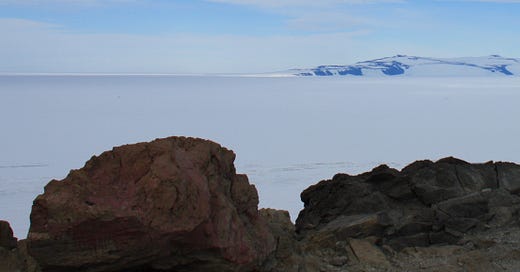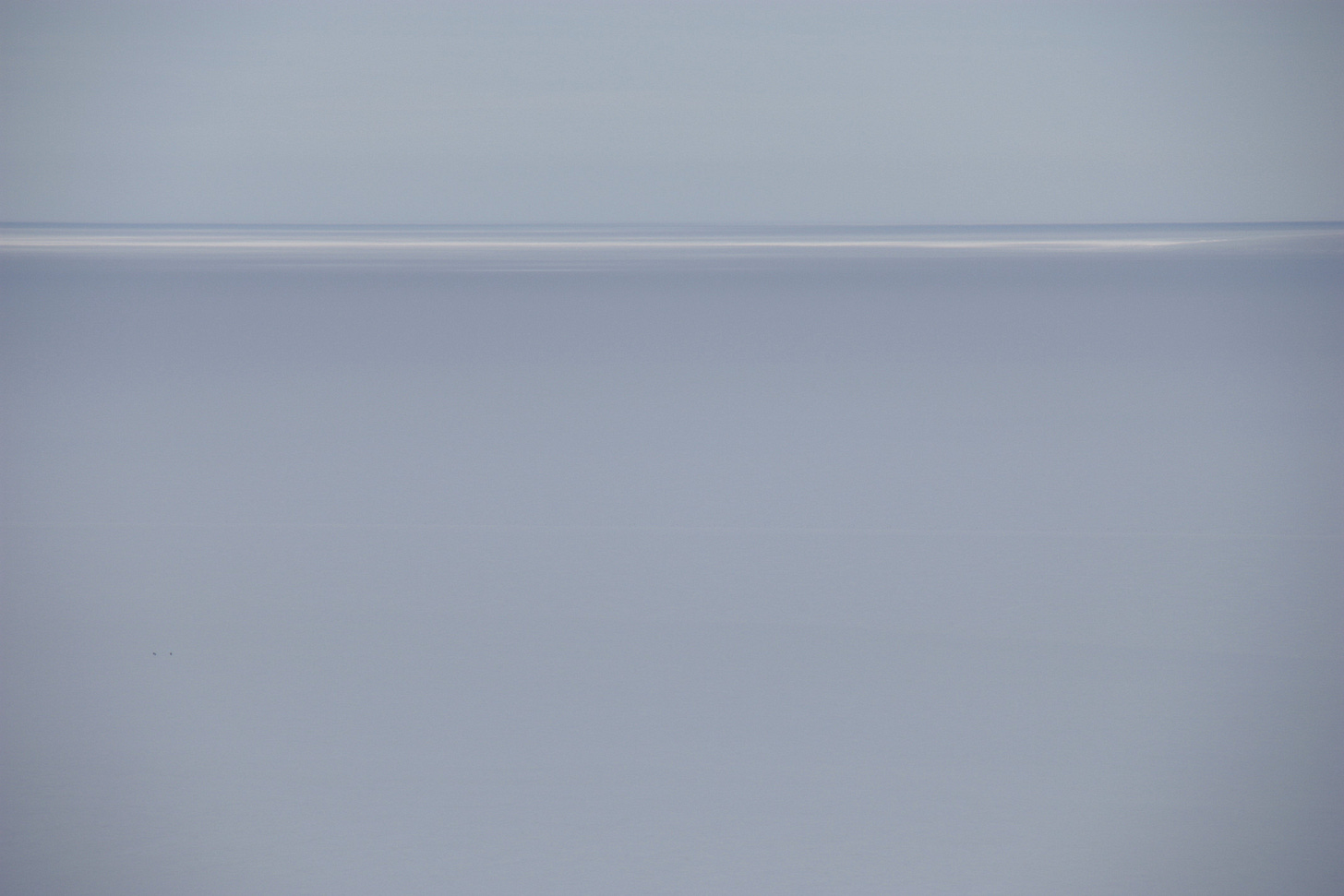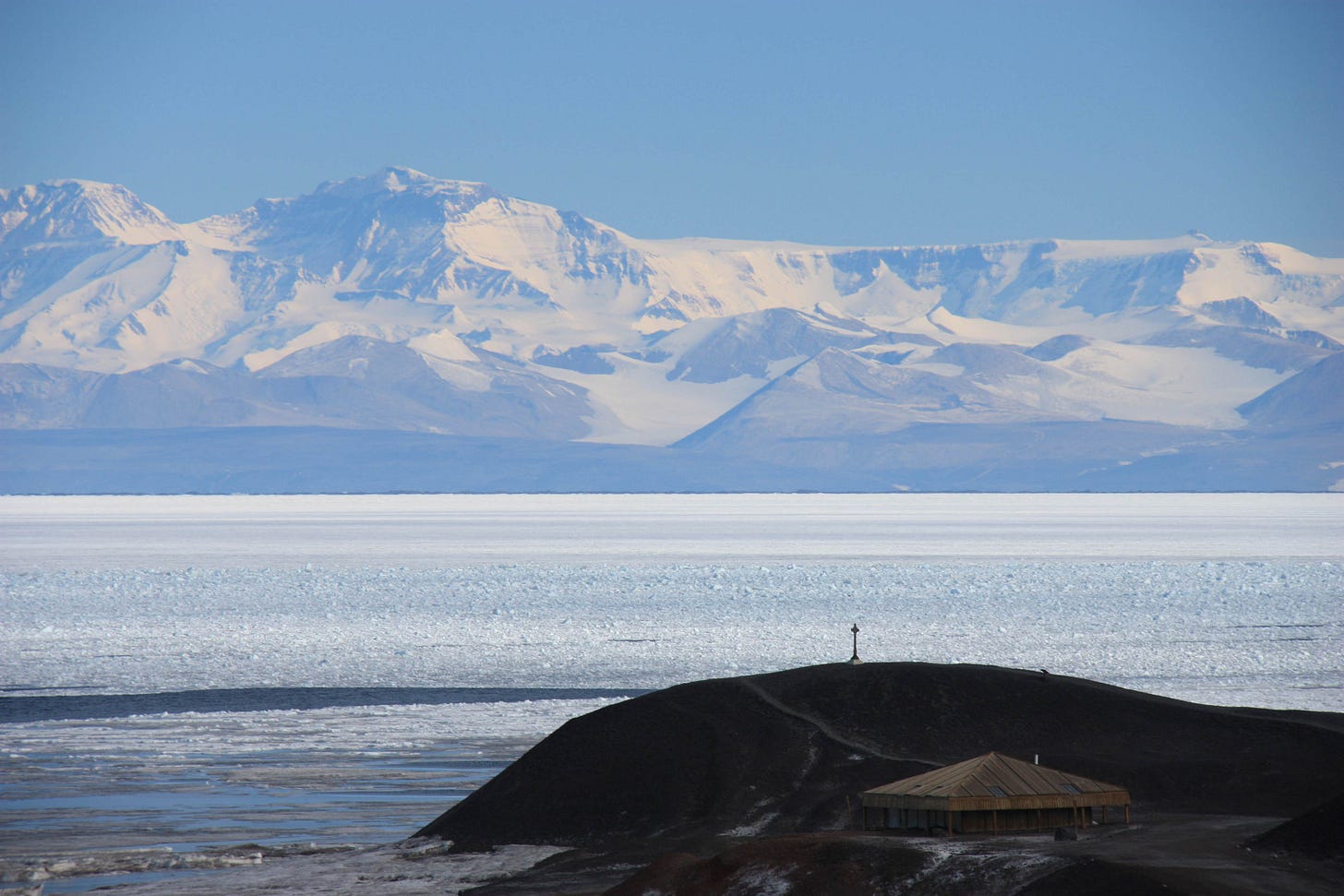A tiny patch of sunlight makes the ice to the left of the island glow. I watch the spot, trying to imagine the men who’d stood where I stood a century before. Each day, the men had trudged up the same track I’d taken, standing near the top of the hill to watch and wait. Their eyes would have been trained on precisely the spot which the sun has chosen to highlight. I shiver, and it’s not the Antarctic cold.
I’m looking south, to the eastern side of White Island, on the Ross Ice Shelf. In late 1911, sixteen men, along with ponies, dogs and two motor sledges, had taken that route, heading in the direction of the South Pole. The motor sledges had failed not far from White Island and had been abandoned. Eleven men and the dogs had turned back at various points along the journey and had arrived safely back at their base. The ponies which had survived as far as the Beardmore Glacier had been shot and their meat stowed for food.
Five men, Robert Falcon Scott, Edward Wilson, “Birdy” Bowers, Edgar Evans and “Titus” Oates, had continued, hoping to reach the South Pole. They were due back in mid-late March of 1912. A couple of men and the dog team had headed out, hoping to meet them, but had seen no sign. Each day, some of the men who were waiting at Hut Point climbed a hill, known as Observation Hill, and hoped to see a distant speck on the horizon. A shadow of the creeping dread they must have felt rises up inside me as I stand on the same hill.
Apsley Cherry-Garrard, in his compelling account of the expedition, says very little of those days of waiting. He writes of the men who travelled to Corner Camp, near White Island, in the hope that they might find the missing men. Then a gap, and an excerpt from his diary which is prefaced with the words a few days later:
We have got to face it now. The Pole Party will not in all probability ever get back. And there is no more that we can do.
from The Worst Journey in the World
In early April, when they reached this conclusion, there was nothing they could do. They returned to their main base, the hut at Cape Evans, and prepared for a desolate winter. The following summer, a group of men set out across the ice shelf, to see if they could find what had happened. They found the tent, the bodies of Scott, Wilson and Bowers, and Scott’s diary. The tent and the bodies, they left on the ice. The diary they brought back.
On Observation Hill, they erected a cross in memory of the five who had died on their return journey from the Pole. To this day, a cross still stands there, although I think the timber has been replaced. It’s beside me as I look south to White Island and contemplate the tragedy.
For me, entirely unused to the conditions and unfit, it was a challenge getting up the hill. The track was narrow and steep, with a thin layer of loose gravel over rock. My feet slipped on occasion and I was shown how to take small, shuffling steps which reduced the chances of me losing my footing. I was glad I managed, though. It was a special privilege to stand on that spot and think of those who’d climbed the hill before me.
There’s no forgetting how unforgiving this environment is. When I read back over the accounts from those days, it seems almost unbelievable that more men didn’t die. They were often pushed to the edge of their endurance, some to near-death, from injuries, scurvy, hypothermia or perhaps just sheer exhaustion. The animals they brought with them suffered more, and many of them died, or were killed. It’s a disturbing part of those original accounts.
I can’t imagine what it must have been like here, just a small group of men, no way to contact the outside world. I think of that last, miserable winter, when they knew Scott and the other men who’d gone to the pole had perished, but didn’t yet know what had happened. The winter’s night, which lasts for months this far south, must have seemed endless.
Despite the sadness, it’s beautiful here. I can see the islands, shapes of black and white, and the distant mountains, tinged pale blue by some trick of the light. There are patches of deep blue where gaps in the sea ice reveal the Ross Sea. Even McMurdo Station, a tangle of roads, buildings, pipes and electricity cables, appears more attractive at this distance. Just past McMurdo, I see the hut which gives Hut Point its name. It was built as part of Scott’s first expedition, from 1901-1904, and it was so miserably cold that it was used for storage and the ship was used for accommodation. The men waiting in vain for Scott to return from the Pole waited for him in that hut. Beyond the hut, at the end of the point, there’s another cross, this one remembering a man who had died on the first expedition, a nagging reminder to the waiting men.
The dignity of my remembrance is ruined by my scramble back down the hill. I’m afraid of sliding down and injuring myself thousands of miles from the nearest hospital. So, I move half-seated, using my hands, feet and bottom to get me down safely. And then I’m back in the 21st century, looking at the oil storage tanks of McMurdo Station. Time for the slow walk back to Scott Base.









Your writing was simultaneously beautiful and foreboding. The photographs were spectacular. My book club is nearing nomination time for next year's reading list. Do you have a book about the Shackleton expedition (or others) that you enjoyed that are Antarctica-focused? We read only non-fiction history and only by exception historical fiction. I have a friend who recently retired from 3M (Minnesota Mining & Manufacturing) -- he has entertained me with stories about keeping warm and dry materials they have developed. It is hard to imagine how folks survived prior to good waterproofing and wicking of sweat materials!!!
Beautiful descriptions and photos. Your words were felt deeply.